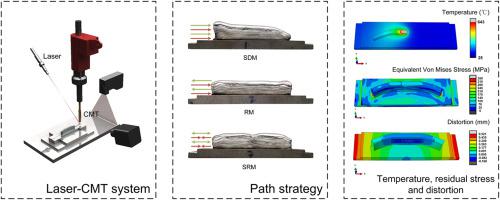Additive Manufacturing ( IF 11.0 ) Pub Date : 2021-07-24 , DOI: 10.1016/j.addma.2021.102203 Runsheng Li 1 , Guilan Wang 2 , Xushan Zhao 3 , Fusheng Dai 1 , Cheng Huang 1 , Mingbo Zhang 2 , Xi Chen 1 , Hao Song 1 , Haiou Zhang 1

|
Laser and cold metal transfer (laser-CMT) hybrid additive manufacturing is a novel process that allows the manufacturing of parts with high deposition rates. Residual stress and distortion caused by high heat input hinder the widespread use of this technology in producing large-scale components. This paper studies the effect of the path strategy on residual stress and distortion in laser-CMT hybrid additive manufacturing. Three path strategies viz. same direction motion (SDM), reciprocating motion (RM), and segmental reciprocating motion (SRM) are chosen. A finite element model is built to predict the residual stress and distortion of the thin-walled part with arc and line features. The adequacy of the model is proven by validation experiments. The thermal cycles are obtained by infrared thermography, the residual stress on the beads is measured by X-ray diffraction, and the distortions of the substrate are scanned by the structure light vision sensor. The temperature gradient, residual stress, and distortion of the samples deposited in different path strategies are analyzed using the validated model. The distortion of the substrate in depositing process by the SRM path strategy is smaller than that of the other path strategies. Finally, a manufacturing case for a commercial aircraft load-carrying frame demonstrates that industries can adopt Finite element (FE) analysis as a tool to optimize the path strategy for laser-CMT hybrid additive manufacturing.
中文翻译:

路径策略对激光和冷金属转移混合增材制造中残余应力和变形的影响
激光和冷金属转移 (laser-CMT) 混合增材制造是一种新颖的工艺,可以制造具有高沉积率的零件。高热输入引起的残余应力和变形阻碍了该技术在生产大型部件中的广泛应用。本文研究了路径策略对激光-CMT混合增材制造中残余应力和变形的影响。三种路径策略即。选择同向运动(SDM)、往复运动(RM)和分段往复运动(SRM)。建立有限元模型来预测具有圆弧和线特征的薄壁零件的残余应力和变形。通过验证实验证明了模型的充分性。热循环是通过红外热成像获得的,通过X射线衍射测量珠子上的残余应力,并通过结构光视觉传感器扫描基板的变形。使用经过验证的模型分析了以不同路径策略沉积的样品的温度梯度、残余应力和变形。SRM路径策略在沉积过程中基板的变形小于其他路径策略。最后,商用飞机承载框架的制造案例表明,行业可以采用有限元 (FE) 分析作为优化激光-CMT 混合增材制造路径策略的工具。使用经过验证的模型分析以不同路径策略沉积的样品的变形和变形。SRM路径策略在沉积过程中基板的变形小于其他路径策略。最后,商用飞机承载框架的制造案例表明,行业可以采用有限元 (FE) 分析作为优化激光-CMT 混合增材制造路径策略的工具。使用经过验证的模型分析以不同路径策略沉积的样品的变形和变形。SRM路径策略在沉积过程中基板的变形小于其他路径策略。最后,商用飞机承载框架的制造案例表明,行业可以采用有限元 (FE) 分析作为优化激光-CMT 混合增材制造路径策略的工具。


























 京公网安备 11010802027423号
京公网安备 11010802027423号